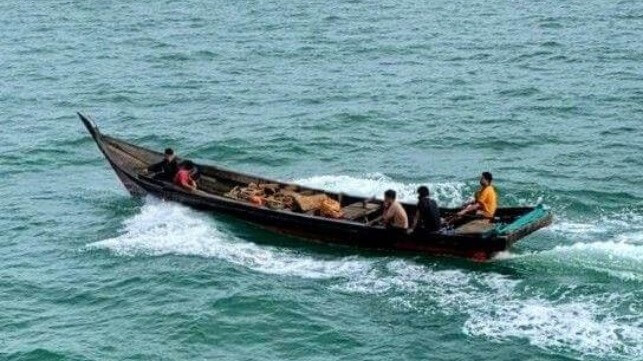Sea Robbery in Singapore Strait Has Serious Consequences

[By Th? Nguy?n Hoàng Anh]
Since the beginning of 2023, sea robbery in the Singapore Strait has increased at an alarming rate. The 113-km long, 19-km wide strait that connects the Indian Ocean with the South China Sea is one of the world’s busiest commercial waterways through which approximately 1,000 ships pass every day. The strait plays a crucial role in international navigation and global trade. However, the traffic density in its narrow waters makes ships vulnerable to sea robbery.
A report released on 9 August by the Regional Cooperation Agreement on Combating Piracy and Armed Robbery against Ships in Asia Information Sharing Centre (ReCAAP ISC) indicates that 51 incidents have occurred on board ships while underway in the strait since January. This number far exceeds the 38 such incidents during the same period last year. The Philip Channel, off Pulau Cula, is a hotspot, even though most cases involved petty theft and caused minor or no injuries to crew members.
The majority of the robberies took place during the hours of darkness. They were opportunistic and non-confrontational in nature, with the perpetrators escaping upon detection by the crew. Target ships tended to share common characteristics such as lack of vigilance, fatigued crew members, having low freeboard, and traversing at slow speed.
Such sea robberies are flourishing in the Singapore Strait because those who commit maritime crime are generally facing financial difficulties brought about by unemployment, slow socio-economic recovery after Covid-19, and depletion of fish stocks. As a consequence, they turn to petty crime, attempting to steal crews’ property and ships’ valuables to earn their livelihood. The criminals also take advantage of the fact that there is inadequate surveillance and enforcement by the littoral states in areas of concern.
Although most sea robbery in the strait is deemed low-level crime, the current spike in incidents has a number of consequences. First, it puts crew members and other individuals on board at risk, both physically and psychologically. Second, the incidents cause loss of property, including engine spares and scrap metal. Third, shipping companies are expected to pay for added security and insurance when operating in areas where sea robbery is prevalent. Fourth, incidents can result in the interruption of maritime transport and adversely impact international trade. In addition, sea robbery can lead to collisions as ships manoeuvre to avoid threat situations, potentially leading to the temporary closure of the strait.
Since the Singapore Strait lies within the territorial waters of Indonesia, Malaysia and Singapore, the three littoral states have been striving to tackle sea robbery and ensure safe navigation. At the national level, government maritime agencies have been developed and patrols have been conducted in their respective waters. At the regional level, the Malacca Straits Patrol was launched in 2004 with the purpose of safeguarding the security of the Straits of Malacca and Singapore. Under this framework, the navies of participating states (Indonesia, Malaysia, Singapore and Thailand) conduct coordinated sea and air patrols. In addition, the Malacca Straits Patrol Information System was established to facilitate the sharing of maritime information. ReCAAP and its Information Security Centre are further evidence of collaborative efforts to suppress piracy and armed robbery against ships in Asia. They have strengthened regional cooperation and provided information and analytics through their periodic reports and incident alerts. This year, the navies of Indonesia and Singapore established CORPAT INDOSIN with the aim of conducting coordinated patrols, holding meetings between senior commanders, sharing information on maritime issues, and facilitating timely responses.
Notwithstanding ongoing efforts, sea robbery in the Singapore Strait continues to evolve. As a result, it is imperative that the region’s littoral states conduct more frequent patrols and surveillance. Relevant law enforcement agencies need to respond in a timely manner to reported incidents and make more effort to arrest and prosecute perpetrators. In these endeavours, accelerating the exchange of information among concerned states, the shipping industry, and regional organisations is a must. Addressing a complex and transnational crime such as sea robbery necessitates stronger collaborative efforts, as no single stakeholder is able to contend with it alone. Each government needs to enhance training on combating sea robbery for shipping companies, ship owners and crews. Training can include but not be limited to how to identify and report potential threats to the authorities and how to respond in the event of an attack.
As recommended by ReCAAP, all ships navigating in the Singapore Strait also have the responsibility to improve their security by installing closed circuit television and motion sensors, maintaining a careful radar watch, hardening doors, and using night vision aids, among other measures. These efforts are vital in reducing the risk of unauthorised boardings and attacks.
Th? Nguy?n Hoàng Anh is pursuing a PhD in Public Policy at the National University of Singapore. She holds an MA in Transnational Governance from the European University Institute and a BA in International Relations from Tokyo International University.
This article appears courtesy of The Lowy Interpreter and may be found in its original form here.
The opinions expressed herein are the author's and not necessarily those of The Maritime Executive.
